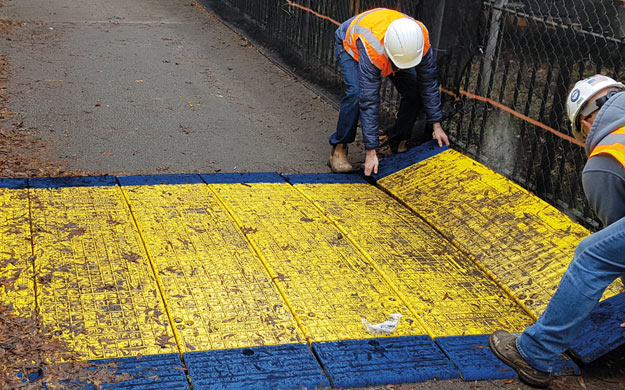Steel Road Plate - An Overview
Wiki Article
The Buzz on Road Plate Steel
Table of ContentsThe Road Plate DiariesLittle Known Questions About Road Plates.The Single Strategy To Use For Steel Road PlateWhat Does Road Plate Do?
Box culverts are economical due to their rigidity and monolithic activity and also separate structures are not called for. It is used in special cases, weak foundation.Normal compaction needs for a job may range from 90% to 95% of standard Proctor for non-structural areas to 98% or even more of customized Proctor for greatly packed pavements. Proctor examinations are dirt moisture-density partnership tests that develop optimum dry density (the device weight of the dirt minus the weight of water) and also the optimal water material for soil samples.
Water is contributed to four to six sections of the dried dirt sample in raising quantities. Each prepared portion is combined into a compaction (proctor) mold with a Proctor Hammer or Mechanical Soil Compactor and afterwards is evaluated and also fixed for moisture web content. The dry thickness boosts as the added dampness lube the soil bits as well as enable better compaction from the very same applied energy.

Road Plates - The Facts
Thickness as well as moisture results are outlined versus the initial lab contour to verify a match. In circumstances where research laboratory information is not available, the area point results may be contrasted to a household of curves put together from local or local soil data to choose the finest optimum thickness as well as optimal wetness curve.A soil compaction test uses one of a number of approaches to measure the dry density and dampness content of the soil in location. The three most typical are gone over below - steel road plate. Results from these field tests are compared to the Proctor test results of the exact same dirt established busy as well as the ratio is revealed as the percent compaction.
All the dug deep into product is meticulously collected and also saved in an impermeable container.
Afterward, the partly filled up apparatus is weighed once more, as well as the quantity of the examination opening is determined by splitting the mass of the sand loading the hole by the mass density of the sand. The wet weight of the recouped excavated dirt is divided by the test opening quantity to figure out the wet density.
Steel Road Plate - An Overview
The percent compaction for the field density test is calculated by separating the completely dry density of the soil by the maximum dry thickness from the proctor examination. Pros, Disadvantages, Accurate as well as reputable; a long history of approved usage, Examinations may take 30 minutes or more to complete, ASTM conventional examination approach, Heavy devices in the area might need to stop procedure briefly, Does not call for substantial training, Different tests should be used where muches of +1 - road plates.
The tests are a little bit simpler to carry out than the sand cone as well as can be duplicated quickly given that the water is preserved in the vessel. Pros, Disadvantages, Accurate and reliable; a long history of accepted usage, Examinations might take 15-20 minutes or more to complete, ASTM conventional examination technique, Balloon membranes can penetrate during testing, Does not need substantial training, Meant for fine-grained or granular dirts without significant quantities of crude product, No licensing or permitting required for usage, Need to not be used to check soft saturated, very plastic dirts, Multiple examinations can be carried out without changing thickness media, All excavated product has to be meticulously gotten rid of, Tools is cost-efficient Wetness web content and unit weight must be done on maintained dirt samples from either a sand cone or rubber balloon tests to complete calculations for dirt compaction.
The graph below shows a few various techniques that can be made use of for dampness determinations as well as there are a selection of ranges and also balances that can be utilized for considering soil samples in research laboratory or area setups. Nuclear density gauges determine soil thickness by measuring gamma radiation transmission between a steel road plate probe containing a radioactive Cesium 137 (or various other) source and Geiger-Mueller detection sensors in the base of the scale.
Getting My Road Plate Steel To Work
Soil dampness is determined at the very same time making use of a different source of Americium 241. A steel rod is driven right into the soil at the examination website, forming a pilot opening. The probe including the radioactive resource is reduced as much as 12in (305mm) right into the pilot opening, and also radiation transmission is gauged for one min.
Report this wiki page